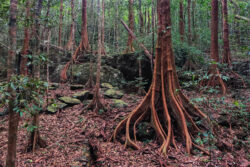The mobile signal was very patchy, one could barely make a phone call, and that too only through one service provider. My colleague Madhusudanan, who was in another antipoaching camp in Cauvery Wildlife Sanctuary was trying to get in touch with me, and it sounded as though he was desperate to give me some urgent information. I was in Uganiya, a forest patrol camp on the banks of River Cauvery, setting camera traps for leopards in this dry protected area that had recently been expanded. Neither of us could communicate that evening.
Next morning when I was in Kaudalli, the range headquarters, to meet the forest official. I managed to check my email and there it was, one of the most surprising photos from our camera-trapping work. A Ratel (Mellivora capensis), also called the Honey Badger, had appeared in one of our camera traps. Madhu had emailed me the images. Wildlife always has the ability to spring surprises. I was very excited as this would be the first photo documentation, and it confirmed evidence of Ratels from the state. The animal had appeared in the Halagur range of the wildlife sanctuary, an area with woodland savannah and dry deciduous forests dominated by Hardwickia trees.
 The Ratel of Cauvery
The Ratel of Cauvery
Three months later, when we completed our camera trapping conducted in this vast 1027 sq km protected area in collaboration with the forest department, we were able to analyse the data for the Ratel. The high encounter rate of the animal during the study revealed that the Ratel may not be uncommon as previously thought. They are perhaps very elusive. Camera traps deployed all over Cauvery Wildlife Sanctuary recorded this carnivorous mammal belonging to Mustelidae, a family of carnivorous mammals that includes otters, badgers, martens and others, in 31 locations and in four out of five forest ranges of the wildlife sanctuary. The camera trapping exercise recorded 41 encounters of the animal in camera traps in varied habitats including scrub, dry deciduous and riverine forests, perhaps indicating that the species had little habitat selectivity within the Cauvery Sanctuary. We also got some pictures of Ratels in pairs.

Furthermore, all camera-trapped images have been captured during the night indicating the nocturnal behaviour of the animal, while it has been documented to be diurnal in nature in Africa. One Ratel image was obtained right on the border of Cauvery and MM Hills Wildlife Sanctuary. Similar ecological characteristics and habitat continuity between the two means that there is a strong likelihood of Ratels occurring in MM Hills too. We could also expect the occurrence of Ratels in the eastern parts of BRT Tiger Reserve (possibly Kollegala range), North Cauvery Wildlife Sanctuary and Satyamangalam Tiger Reserve, and other adjoining reserved forests (Mallahalli, Natrapalaiyam, Biligundlu, Voddappatti, Bevanurmalai, Kestur, Bilikal and Badanavadi) in Tamil Nadu due to similar habitats.
The Ratel in Cauvery is perhaps its southernmost recorded range and previous evidences come from Nagarjunsagar Srisailam Tiger Reserve in Andhra Pradesh. However, there is a need for intensive research to know more about the distribution of Ratels in Karnataka and other areas. Apart from the Ratel, we also recorded seven other small carnivores – Jungle Cat, Rusty-spotted Cat, Common Palm Civet, Small Indian Civet, Ruddy Mongoose, Indian Grey Mongoose and Smooth-coated Otter from Cauvery Wildlife Sanctuary.

A short film on the Ratel and other small carnivores of Cauvery can be viewed here.
The Kannada version of the video is here.
The most interesting picture occurred in a camera trap set by the forest department where a Ratel and a leopard were photographed together near a waterhole. I hope the Ratel did not bother the leopard!






Instagram
junglelodgesjlr